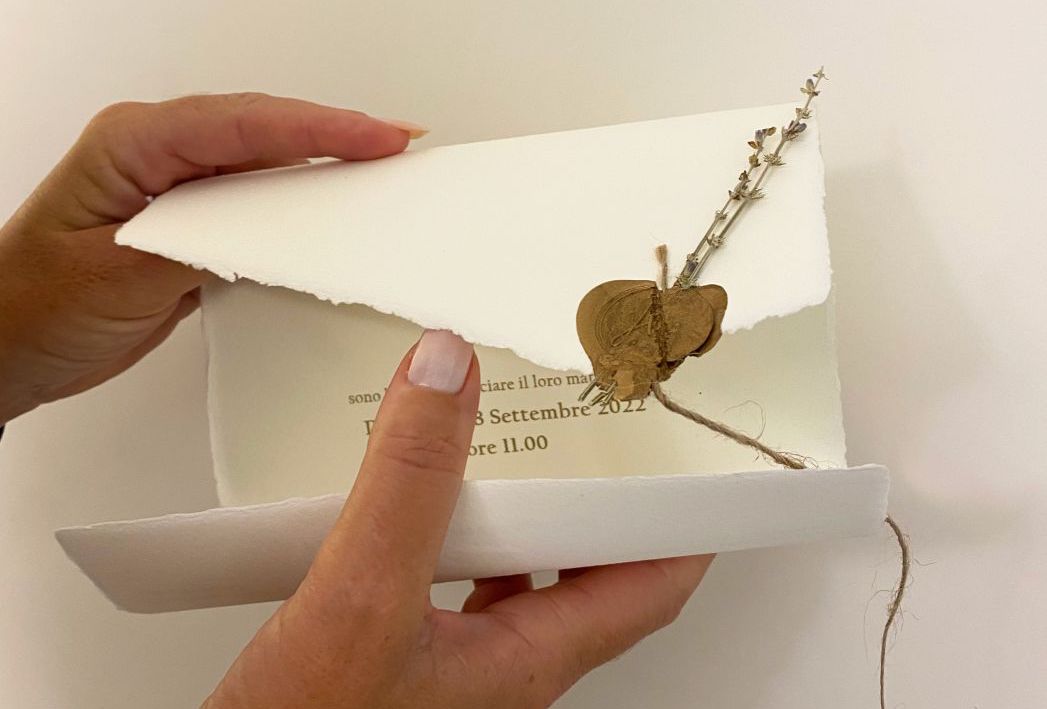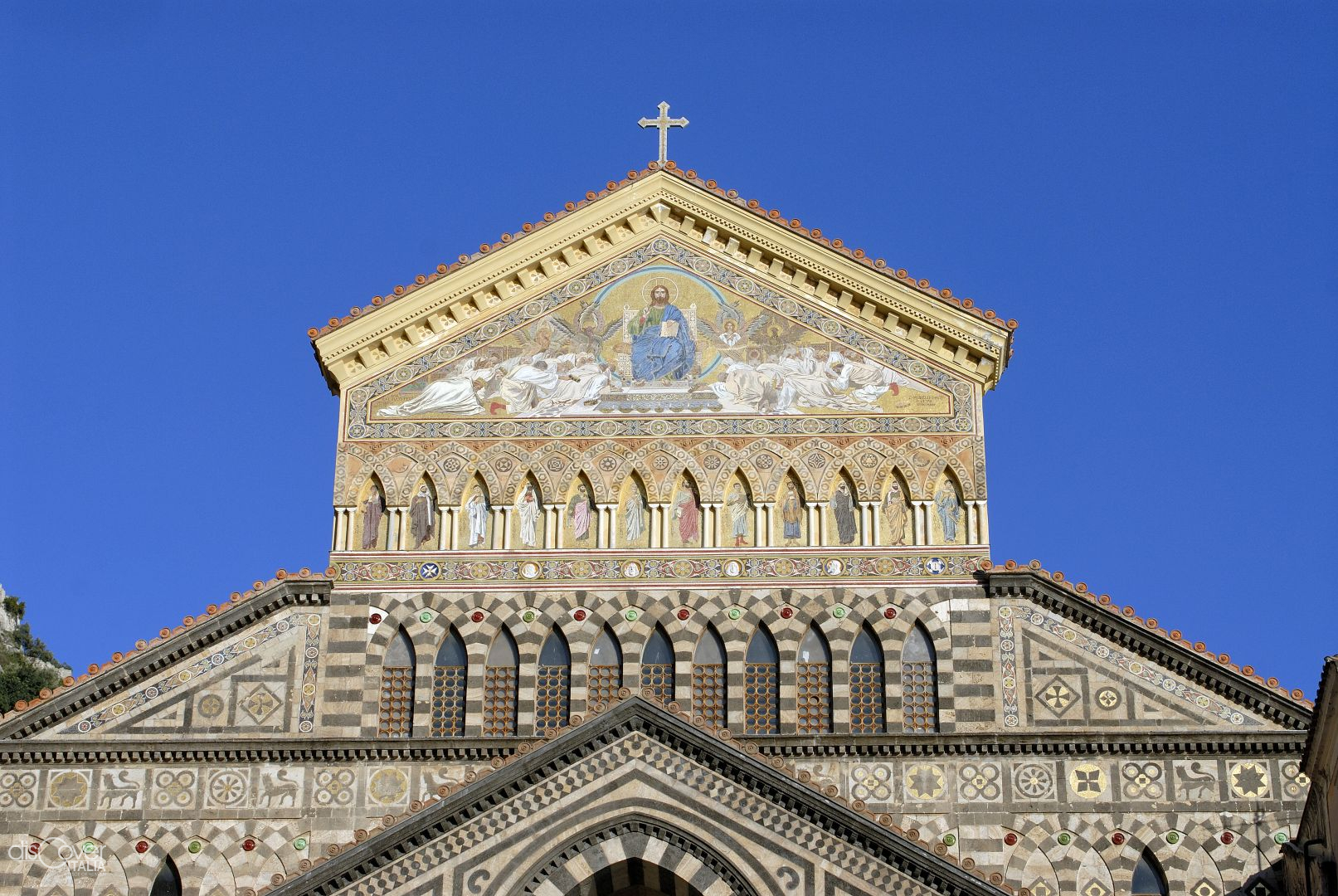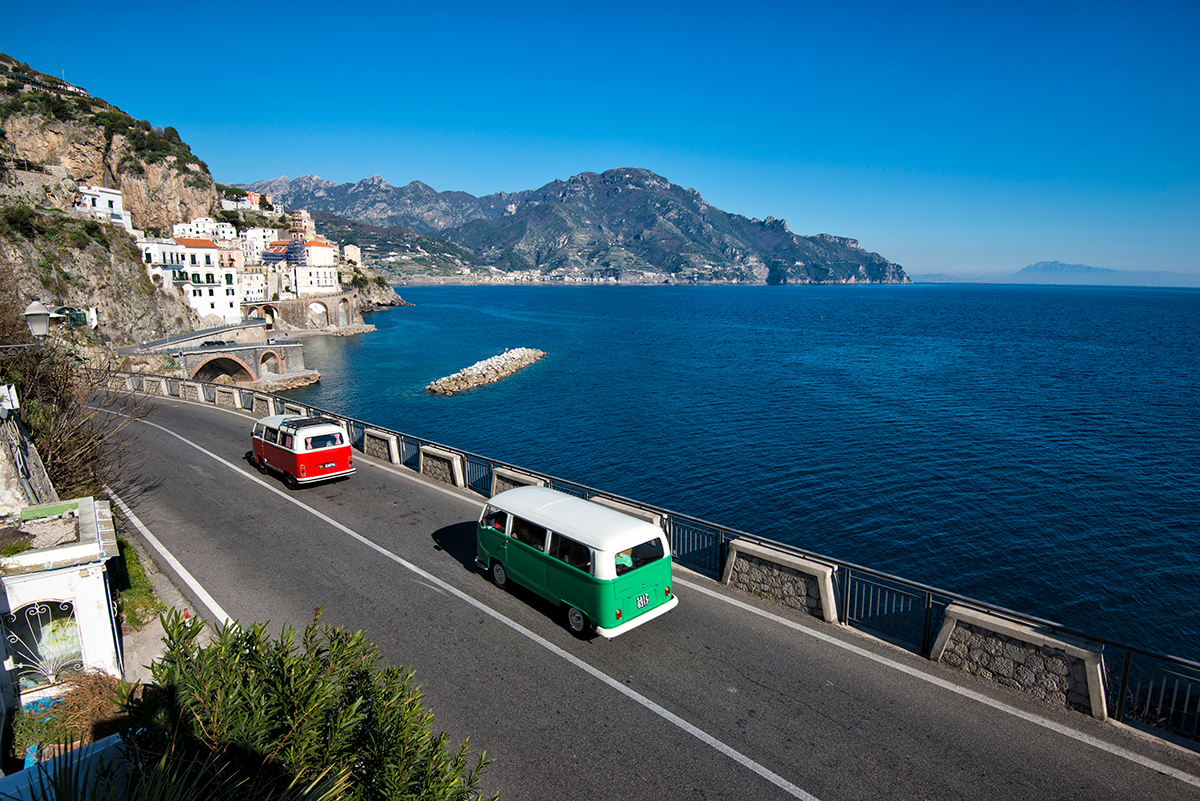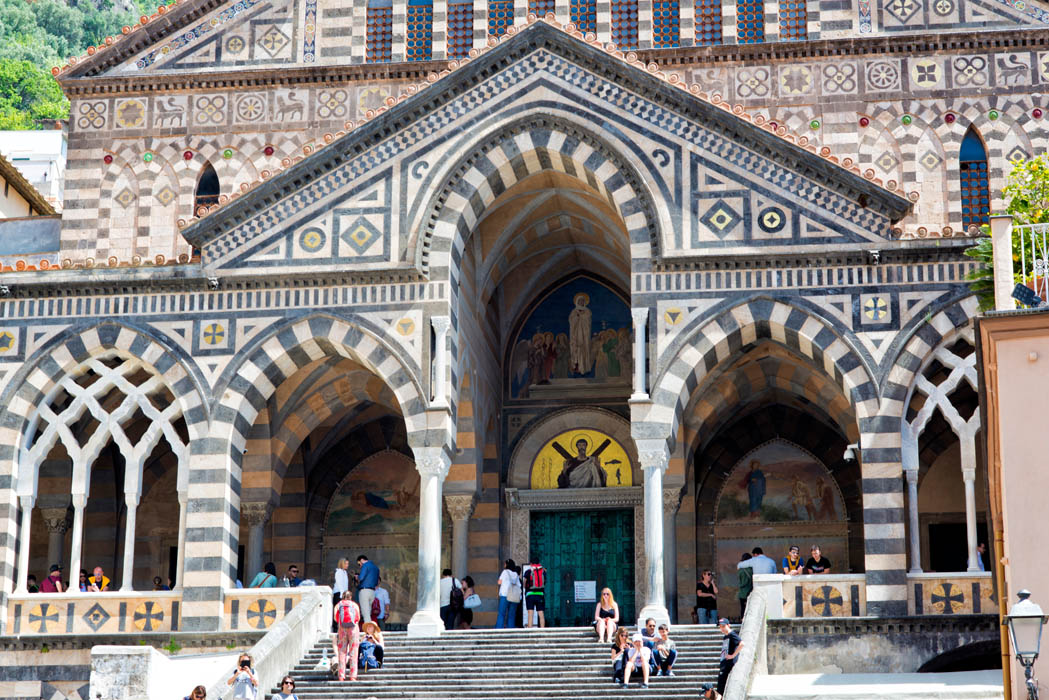High up, inland, on a spur of rock wedged between the valley formed by the torrent Dragone and the one deriving from the torrent Reginna.
 Compared to the other pearls of the Coast, Ravello benefits from an important strategic position, which if once was functional to the defense of the territory of the Republic of Amalfi, behind its maritime centres, today is precious for the special perspective it offers on the coast of the Sirens and on the gulf of Salerno. In fact, although it is directly connected only with the two districts of Cosma and Castiglione, Ravello is fed everywhere by the beauty of the sea, a constant presence in the magnificent panoramas that have inspired writers, artists and musicians of all time. From Boccaccio, who chose the merchant from Ravello Landolfo Rufolo as the protagonist of one of the most beautiful novellas of the Decameron, to William Turner, who in 1819 fixed the most picturesque views in his sketches, until conquering Richard Wagner, who found the enchanted Garden by Klingsor of his Parsifal.
Compared to the other pearls of the Coast, Ravello benefits from an important strategic position, which if once was functional to the defense of the territory of the Republic of Amalfi, behind its maritime centres, today is precious for the special perspective it offers on the coast of the Sirens and on the gulf of Salerno. In fact, although it is directly connected only with the two districts of Cosma and Castiglione, Ravello is fed everywhere by the beauty of the sea, a constant presence in the magnificent panoramas that have inspired writers, artists and musicians of all time. From Boccaccio, who chose the merchant from Ravello Landolfo Rufolo as the protagonist of one of the most beautiful novellas of the Decameron, to William Turner, who in 1819 fixed the most picturesque views in his sketches, until conquering Richard Wagner, who found the enchanted Garden by Klingsor of his Parsifal.
It was precisely the position of the cliff, which guaranteed a natural protection compared to the more exposed coastal zones, which attracted the first inhabitants in the 5th century AD. Although the legend attributes the foundation of Ravello to Amalfi people obliged to leave their town for the conflicts within the power groups of that time. Certainly, the historical events of Ravello were marked for centuries by the relationship with the nearby Amalfi. Initially, as an integral part of the territory of the Republic and of the Duchy, of which Ravello represented one of the fundamental defensive bulwarks and from which it drew its prosperity linked to the intense trade with Byzantium and with other Mediterranean countries and, later, during the period of Amalfi dependence on the Normans, they exploited the latter’s interest in favoring Ravello nobility in order to balance the power and the prosperity of the Amalfi one. Having suffered, like the other communities of the Coast, the devastation carried out by the Pisans in 1137, under the Swabians, Ravello families were rich and influen again at the court of Frederick II and his successors. It was the last phase of strong demographic growth in the city, then, under the Angevins, the twenty-year Vespers War with the Aragonese hit the economy of the coast to death. The exodus of the noble families to Naples started in the 14th century, where they obtained leading roles, and the progressive depopulation continued in the following centuries, together with an unstoppable economic decline. The discovery of its beauty, at the time of the Grand Tour, gave Ravello a new identity as a favourite destination for men of culture of the most diverse backgrounds.
THE CATHEDRAL AND THE CHURCHES
The numerous churches are the symbol of the power and the wealth of Ravello inhabitants in the Middle Ages. Ravello reached the number of one hundred. Among the ones which came down to us, there is in the centre the Cathedral of Santa Maria Assunta and of San Pantaleone, where an ampoule with the blood of the Saint is kept since 1112, and which every year renews the miracle of liquefaction. Built in 1086-1087 according to the model of the Abbey of Montecassino, it is one of the most ancient cathedrals in Italy. The imposing central portal, with bronze tiles of Arab- Byzantine inspiration, was built in 1179 by Barisano da Trani. Subjected to several changes, especially during the Baroque Age, the Cathedral still has the two-floors bell-tower of the 13th century with double-arched windows and intertwined arches. Inside, the hall with three aisles houses, facing each other, two very precious ambons with magnificent marble inlays: the “Ambone del Vangelo” (the Ambon of the Gospel) by Nicola di Bartolomeo da Foggia from 1272 and another with the story of the prophet Jonah, of Byzantine origin. In the crypt, there is he Museum of the Opera with Roman cinerary urns, early Christian reliquaries and individual pieces from the works of the Cathedral above, like the bust of Sigilgaida Rufolo by Nicola di Bartolomeo da Foggia, parts of the medieval bestiary of the ancient ciborium of the cathedral of Matteo da Narni and Il falconiere (The falconer), a sculpture dating back to the reign of Frederick II. From the left aisle of the Cathedral, you can access the gallery of medieval and moderne art (Pinacoteca d’arte medievale e moderna) with the paintings of the Cathedral and other churches between the 14th and the 19th century: among which the polyptych by Giovanni Filippo Criscuolo, works of Giovanni Angelo and of Giovanni Antonio D’Amato.
Near the Duomo, the church of Sant’Angelo dell’Ospedale is even older because it is prior to 1039, and is built inside a natural cavity. Behind the gabled facade framed by two columns, two areas are separated by an altar. The most internal and ancient part is closed by an apse whose walls are welded to the rock. On the altar, a fresco represents the Madonna and Child. The bell-tower with four floors is also particular, some of them are reclined against the rock. Near the Duomo there is also the church of Santa Maria delle Grazie from the 11th century, of Romanesque style with a quadrangular plan. It preserves frescoed parts and a simulacrum of the Madonna delle Grazie. The Church of Santa Maria a Gradillo is coeval, with a Latin cross and three naves. The dome rises on the central span of the transept. The altar is formed by the slab of a sarcophagus. An ancient mosaic with the tree of life is of particular value. The three-storey bell-tower ends with a circular cell and a dome with coloured tuff decorative motifs. The Church of San Giovanni del Toro was consecrated in 1276 by the bishop Pietro di Durazzo. The nobility gathered there in the Middle Ages. In Romanesque style with a gabled facade, it has three naves with apses. The ambo with a mosaic decoration is very old. Near the entrance of the sacristy there is a fresco of the Risen Christ between two Marys from the end of the sixteenth century by Roberto d’Oderisio, while in the Coppola chapel there are remains of the frescoes from Giotto school. In the crypt, there is a cycle of paintings from the 14th century with the Christ Pantocrator in the centre and figures of Saints and angels. The bell-tower with a square plan has two floors with decorated double-arched windows.
According to tradition, it is probably Saint Francis of Assisi who founded the monastery with the adjacent church dedicated to him in 1222, while on his way to Amalfi. Originally, the church was in Gothic style with three naves and eight chapels. Only the transept and the apse remain. In the adjoining convent there are the remains of the Blessed Bonaventura da Potenza. Built on the slopes of the cliff down to the sea, the church of San Pietro alla Costa is the oldest in Ravello, from the 10th century. Romanesque, the entrance has a portico supported by columns with Roman capitals. The interior has three naves divided by granite colonnades. A road from 1305 connects it to the ancient church of Azzunziata from 1281, which with its domes has become one of the symbols of the city. For centuries, between various events, it was patronised by royal concession of the Fusco family, whose emblem bears above the entrance. The ancient church is connected to an oratory, the “new church” preceded by a portico appearing like a gallery in the rock. With a basilica plan with three naves, the peculiarity lies in the dome, which rises from the central nave. It was rich in art works which were then transferred elsewhere and it currently used as an exhibition and conference space.
THE PALACES, THE VILLAS
Each of the influent families of the city had one, located in the noble neighbourhood of Toro. Therefore, the succession of warehouse buildings along the axis which from north to south connects Piazza Fontana, where the Moresca Fountain is, to Piazza Duomo is a perfect synthesis of the mercantile history of medieval Ravello. In large part, starting from the oldest, the Rogadeo Palace in Piazza Fontana, they became hotels since the nineteenth century.
Ultimo della serie, in piazza Duomo, è il palazzo meglio conosciuto come Villa Rufolo, residenza della famiglia più ricca e potente di Ravello, citato anche da Boccaccio (che probabilmente vi fu ospite) nella seconda novella della quarta giornata del Decameron. I contatti commerciali della famiglia con l’Oriente si ritrovano negli elementi arabi e bizantini che caratterizzarono la fabbrica duecentesca, commissionata da Nicola Rufolo, con un ruolo di primo piano alla corte sveva di Manfredi. La villa passò in seguito ad altri proprietari e nel tempo andò incontro a una progressiva decadenza. Fin quando a metà ‘800 fu acquistata dal lord scozzese Francis Neville Reid, che ne avviò il totale restauro, donandole l’aspetto attuale. Mantiene la sua impronta medievale la torre d’ingresso con le quattro statue della Carità e dell’Ospitalità. All’interno c’è un’altra torre, la Maggiore, alta trenta metri, che domina i magnifici giardini terrazzati affacciati sul panorama della Costiera e del golfo. La villa è stata completamente restaurata e le sale sono da tempo destinate a mostre e attività culturali. Ma la vocazione moderna dell’intero complesso è legata alla visita che vi compì Richard Wagner nel 1880, rimanendone fortemente colpito e ispirato, tanto da immaginarvi ambientato il Giardino Klingsor del secondo atto del Parsifal. Così nel 1953 Villa Rufolo divenne sede dei Concerti Wagneriani che fecero di Ravello “la città della musica”. Divenuta la villa bene pubblico e affidata la sua gestione alla Fondazione Ravello, dal 2003 è nato il Ravello Festival.
E’ in piazza Duomo anche il Camo, il Museo del Corallo, che propone una preziosa collezione di pezzi unici di varie epoche e di straordinaria fattura, come una tabacchiera del ‘700 incrostata di cammei. E’ aperto tutti i giorni dal lunedì al giovedì.
Cimbronium era l’antico nome del promontorio con vista mozzafiato sul golfo di Salerno su cui sorge la splendida Villa Cimbrone, un altro dei gioielli di Ravello. Edificata nell’XI secolo, la villa fu proprietà nel tempo di alcune delle famiglie più in vista della città. Ma era ridotta piuttosto male quando, nel 1904 fu acquistata Ernest William Beckett, un banchiere inglese che provvide al rifacimento dell’intero complesso, compreso il magnifico giardino, arricchito da piante rare, statue, fontane, grotte ed elementi architettonici gotici e neoclassici. Grande cura fu dedicata anche al restyling del parco, che rappresenta una felice armonizzazione del giardino classico all’italiana con le caratteristiche di naturalità del giardino all’inglese. Trasformata la villa in hotel a 5 stelle, il parco è aperto al pubblico e può essere visitato tutto l’anno. E si può ammirare lo spettacolare panorama fino alla costa cilentana offerto dalla Terrazza sull’infinito a cui conducono tutti i viali interni della villa.











Comments powered by CComment